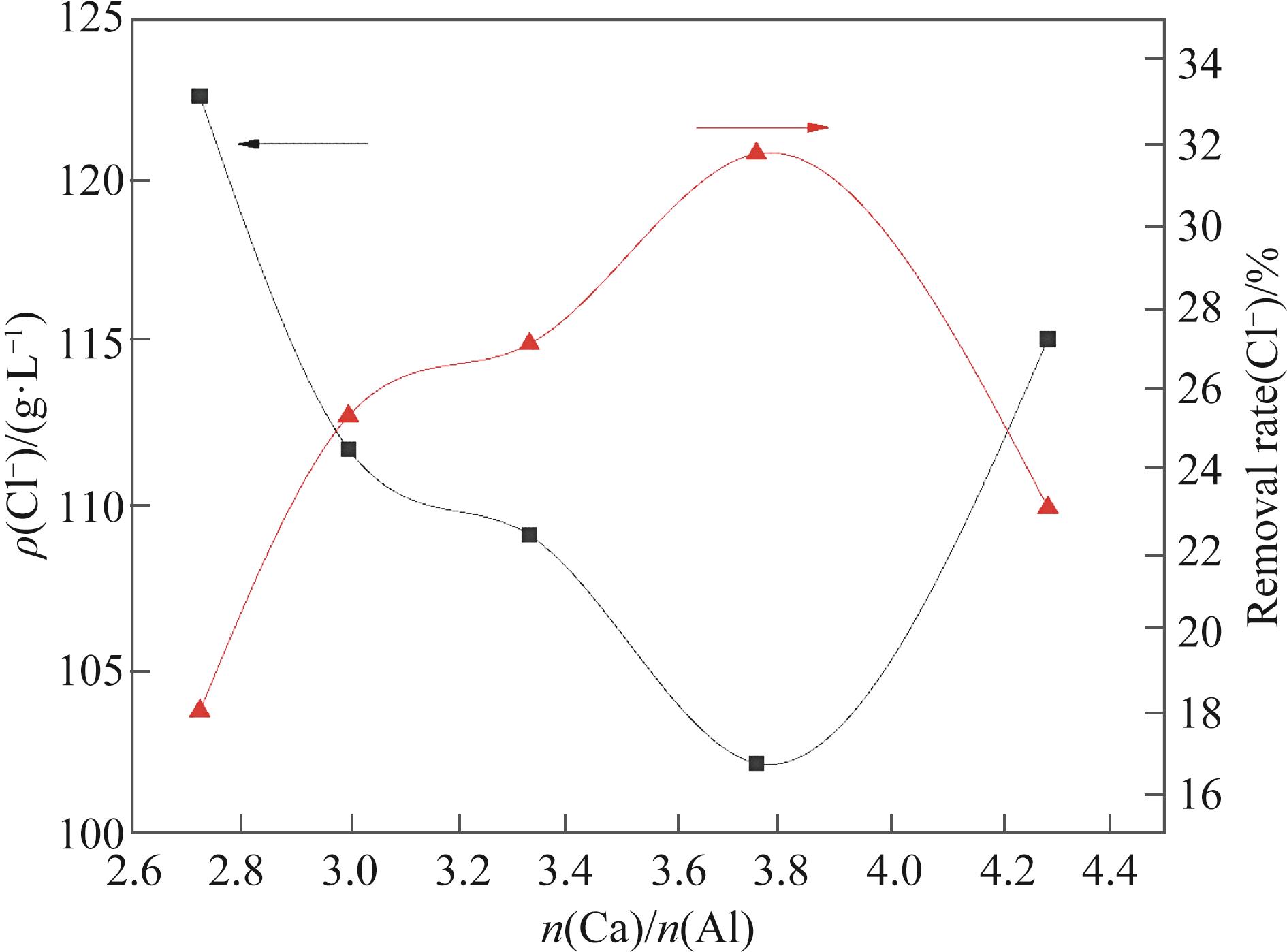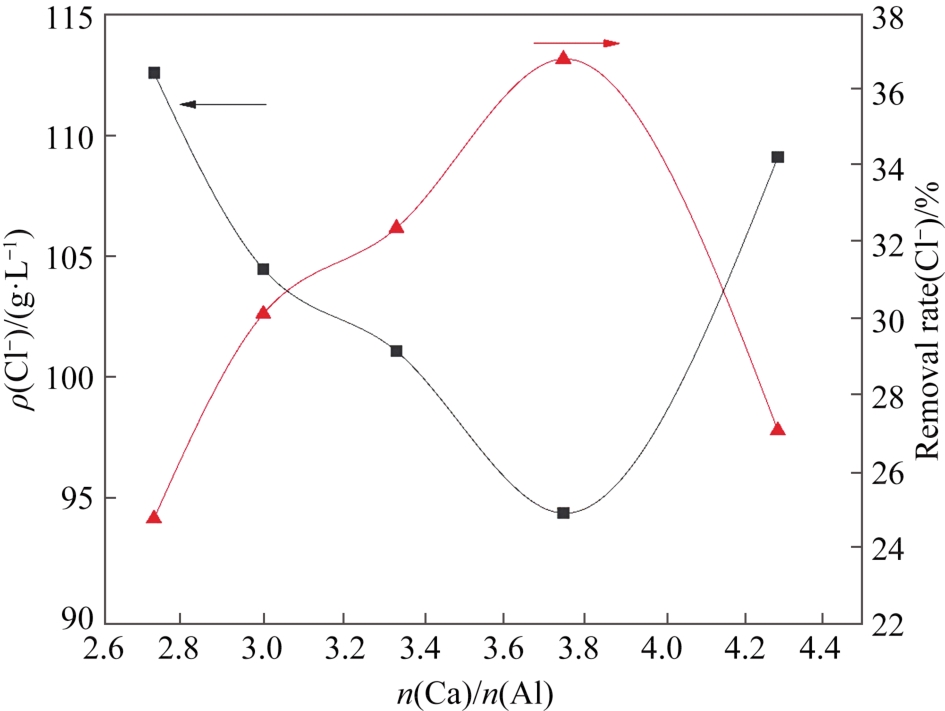
Chinese Journal of Applied Chemistry ›› 2022, Vol. 39 ›› Issue (9): 1437-1446.DOI: 10.19894/j.issn.1000-0518.210544
• Full Papers • Previous Articles Next Articles
Effect of Chlorine Removal on Crystallization in the Mother Liquor of Ammonium Sulfate
Gao-Yong ZI1,2, Bang-Fu HUANG1,2( ), Meng DAI1,2, Zheng-Yu YANG1,2, Zhen-Jing WEN1,2, Wan-Jun LI1,2, Liu-Bin LUO1,2
), Meng DAI1,2, Zheng-Yu YANG1,2, Zhen-Jing WEN1,2, Wan-Jun LI1,2, Liu-Bin LUO1,2
- 1.Faculty of Metallurgical and Energy Engineering,Kunming University of Science and Technology,Kunming 650093,China
2.Clean Metallurgy Key Laboratory of Complex Iron Resources,University of Yunnan Province,Kunming 650093,China
-
Received:2021-11-23Accepted:2022-02-28Published:2022-09-01Online:2022-09-08 -
Contact:Bang-Fu HUANG -
About author:kmusthbf@163.com
-
Supported by:the General Project of Applied Basic Research Program of Yunnan Province(202001AT070029);the Open Foundation of Key Laboratory of Iron and Steel Metallurgy and Resource Utilization of Ministry of Education(FMRUlab?20?4)
CLC Number:
Cite this article
Gao-Yong ZI, Bang-Fu HUANG, Meng DAI, Zheng-Yu YANG, Zhen-Jing WEN, Wan-Jun LI, Liu-Bin LUO. Effect of Chlorine Removal on Crystallization in the Mother Liquor of Ammonium Sulfate[J]. Chinese Journal of Applied Chemistry, 2022, 39(9): 1437-1446.
share this article
Add to citation manager EndNote|Ris|BibTeX
URL: http://yyhx.ciac.jl.cn/EN/10.19894/j.issn.1000-0518.210544
序号 Num | 除氯剂 Dechlorination agent | 结晶量 Crystallization amount/g | 平均粒径 The average particle size/mm | C.V.值 C.V.value |
|---|---|---|---|---|
| 1 | —— | 138.600 | 1.151 | 509.247 |
| 2 | 3.0 g CaSO4+0.7 g NaAlO2 | 58.652 | 1.634 | 720.521 |
| 3 | 3.0 g CaSO4+0.8 g NaAlO2 | 54.311 | 1.602 | 768.410 |
| 4 | 3.0 g CaSO4+0.9 g NaAlO2 | 51.003 | 1.179 | 524.256 |
| 5 | 3.0 g CaSO4+1.0 g NaAlO2 | 48.011 | 1.568 | 685.040 |
| 6 | 3.0 g CaSO4+1.1 g NaAlO2 | 45.554 | 1.816 | 647.973 |
Table 1 Effect of dechlorination by calcium sulfate aluminum method on the crystalline amount, average particle size and C.V. value of ammonium sulfate crystals
序号 Num | 除氯剂 Dechlorination agent | 结晶量 Crystallization amount/g | 平均粒径 The average particle size/mm | C.V.值 C.V.value |
|---|---|---|---|---|
| 1 | —— | 138.600 | 1.151 | 509.247 |
| 2 | 3.0 g CaSO4+0.7 g NaAlO2 | 58.652 | 1.634 | 720.521 |
| 3 | 3.0 g CaSO4+0.8 g NaAlO2 | 54.311 | 1.602 | 768.410 |
| 4 | 3.0 g CaSO4+0.9 g NaAlO2 | 51.003 | 1.179 | 524.256 |
| 5 | 3.0 g CaSO4+1.0 g NaAlO2 | 48.011 | 1.568 | 685.040 |
| 6 | 3.0 g CaSO4+1.1 g NaAlO2 | 45.554 | 1.816 | 647.973 |
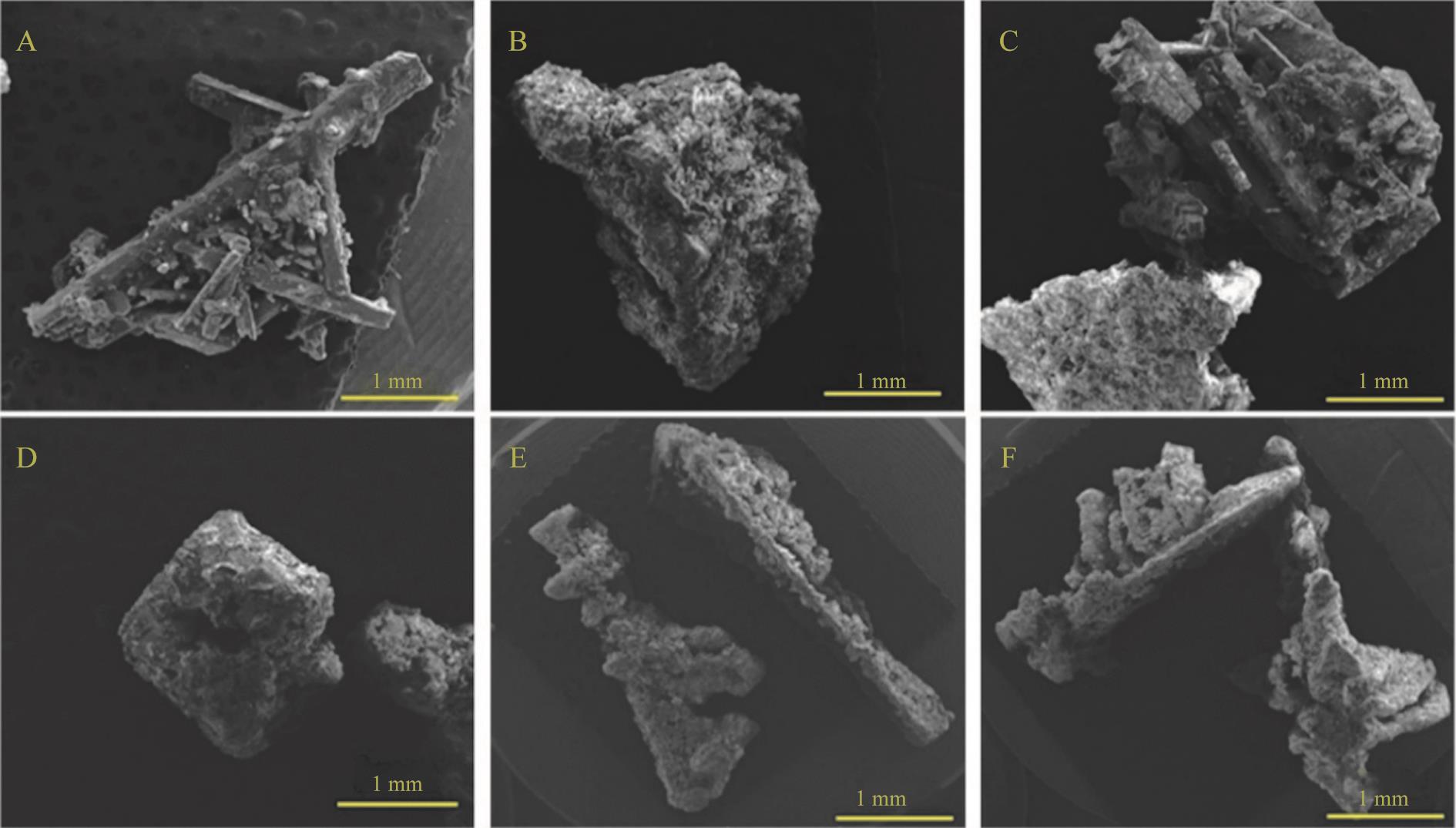
Fig.2 Effect of dechlorination by calcium sulfate aluminum on the morphology of ammonium sulfate crystals(A) Stock solution; (B) 3.0 g CaSO4+0.7 g NaAlO2; (C) 3.0 g CaSO4+0.8 g NaAlO2; (D) 3.0 g CaSO4+0.9 g NaAlO2; (E) 3.0 g CaSO4+1.0 g NaAlO2; (F) 3.0 g CaSO4+1.1 g NaAlO2
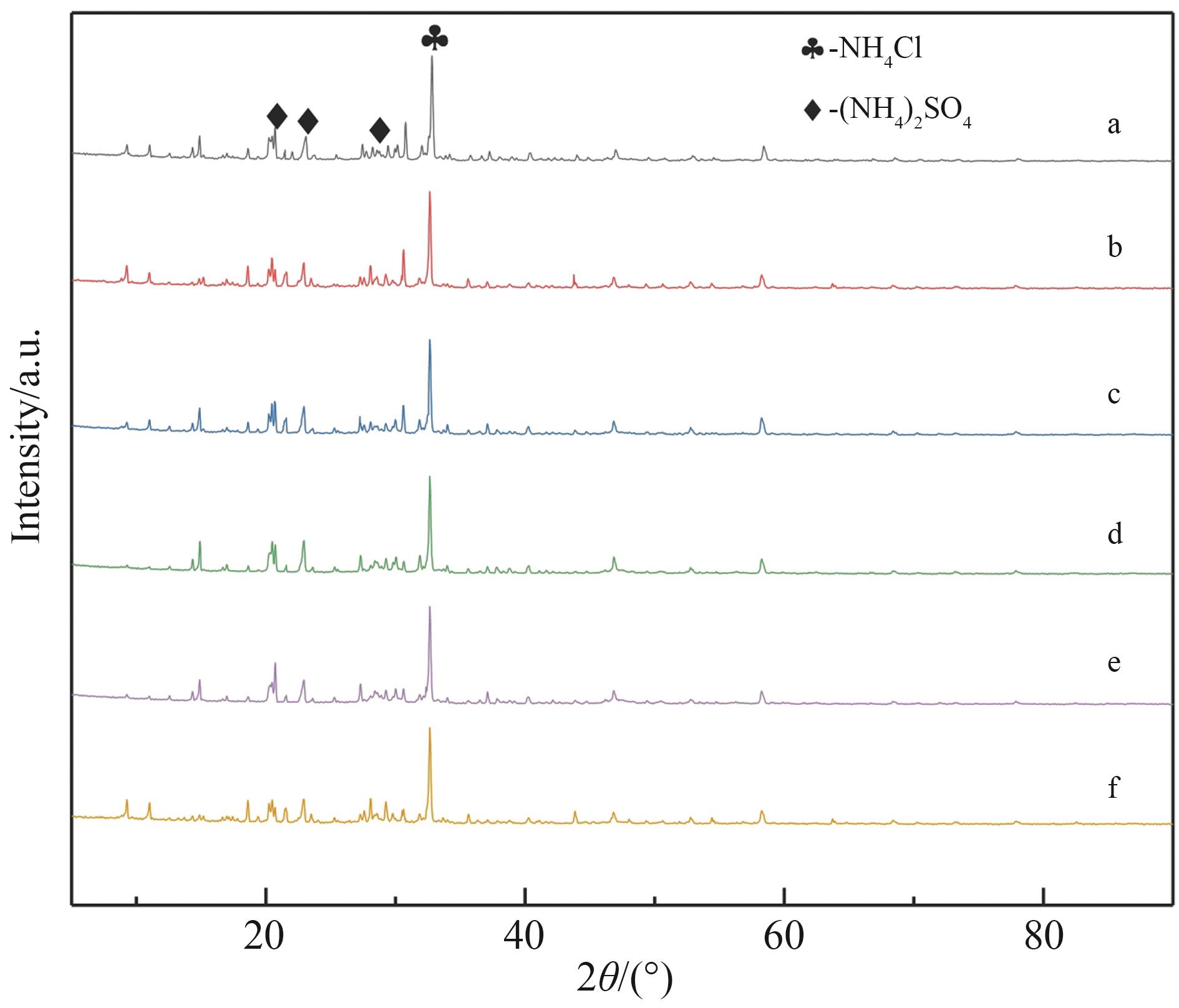
Fig.3 XRD diffraction pattern of ammonium sulfate crystals after dechlorination by calcium sulfate aluminum methoda. Stock solution; b. 3.0 g CaSO4+0.7 g NaAlO2; c. 3.0 g CaSO4+0.8 g NaAlO2; d. 3.0 g CaSO4+0.9 g NaAlO2; e. 3.0 g CaSO4+1.0 g NaAlO2; f. 3.0 g CaSO4+1.1 g NaAlO2
序号 Num | 除氯剂 Dechlorination agent | 结晶量 Crystallization amount/g | 平均粒径 The average particle size/mm | C.V.值 C.V.value |
|---|---|---|---|---|
| 1 | —— | 138.600 | 1.151 | 509.247 |
| 2 | 3.0 g脱硫灰+0.7 g NaAlO2 3.0 g Desulfurization ash +0.7 g NaAlO2 | 149.840 | 1.150 | 407.790 |
| 3 | 3.0 g脱硫灰+0.8 g NaAlO2 3.0 g Desulfurization ash+0.8 g NaAlO2 | 145.614 | 1.112 | 427.378 |
| 4 | 3.0 g脱硫灰+0.9 g NaAlO2 3.0 g Desulfurization ash+0.9 g NaAlO2 | 163.662 | 1.091 | 397.555 |
| 5 | 3.0 g脱硫灰+1.0 g NaAlO2 3.0 g Desulfurization ash+1.0 g NaAlO2 | 153.138 | 1.063 | 382.120 |
| 6 | 3.0 g脱硫灰+1.1 g NaAlO2 3.0 g Desulfurization ash+1.1 g NaAlO2 | 141.383 | 1.092 | 403.825 |
Table 2 Effect of dechlorination by desulfurization ash aluminum method on the crystallization amount, average particle size and C.V. value of ammonium sulfate crystals
序号 Num | 除氯剂 Dechlorination agent | 结晶量 Crystallization amount/g | 平均粒径 The average particle size/mm | C.V.值 C.V.value |
|---|---|---|---|---|
| 1 | —— | 138.600 | 1.151 | 509.247 |
| 2 | 3.0 g脱硫灰+0.7 g NaAlO2 3.0 g Desulfurization ash +0.7 g NaAlO2 | 149.840 | 1.150 | 407.790 |
| 3 | 3.0 g脱硫灰+0.8 g NaAlO2 3.0 g Desulfurization ash+0.8 g NaAlO2 | 145.614 | 1.112 | 427.378 |
| 4 | 3.0 g脱硫灰+0.9 g NaAlO2 3.0 g Desulfurization ash+0.9 g NaAlO2 | 163.662 | 1.091 | 397.555 |
| 5 | 3.0 g脱硫灰+1.0 g NaAlO2 3.0 g Desulfurization ash+1.0 g NaAlO2 | 153.138 | 1.063 | 382.120 |
| 6 | 3.0 g脱硫灰+1.1 g NaAlO2 3.0 g Desulfurization ash+1.1 g NaAlO2 | 141.383 | 1.092 | 403.825 |
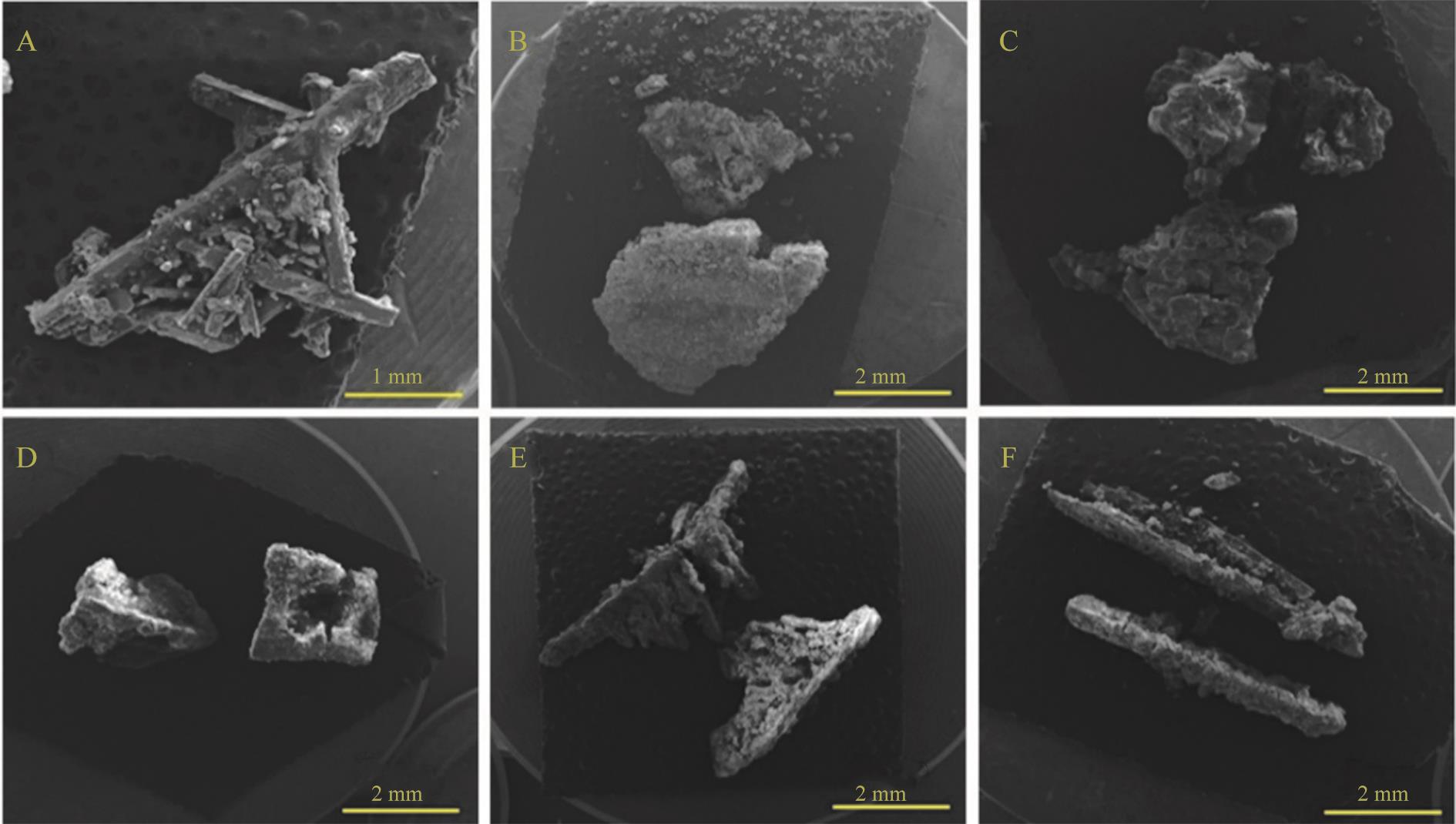
Fig.5 Effect of dechlorination by desulfurization ash aluminum method on the morphology of ammonium sulfate crystals(A) Stock solution; (B) 3.0 g Desulfurization ash +0.7 g NaAlO2; (C) 3.0 g Desulfurization ash+0.8 g NaAlO2; (D) 3.0 g Desulfurization ash +0.9 g NaAlO2; (E) 3.0 g Desulfurization ash+1.0 g NaAlO2; (F) 3.0 g Desulfurization ash+1.1 g NaAlO2

Fig.6 XRD diffraction pattern of ammonium sulfate crystals after dechlorination by desulfurization ash aluminum methoda. Stock solution; b. 3.0 g Desulfurization ash +0.7 g NaAlO2; c. 3.0 g Desulfurization ash +0.8 g NaAlO2; d. 3.0 g Desulfurization ash +0.9 g NaAlO2; e. 3.0 g Desulfurization ash +1.0 g NaAlO2; f. 3.0 g Desulfurization ash +1.1 g NaAlO2
| 1 | 赵春丽, 吴铁, 伯鑫, 等. 钢铁行业烧结烟气脱硫现状及协同治理对策建议[J]. 环境工程, 2014, 32(10): 76-78, 103. |
| ZHAO C L, WU T, BO X, et al. The status quo of Sinteing flue gas desulfurization of iron & steel industry and pollutants co-treatment suggestion[J]. Environ Eng, 2014, 32(10): 76-78, 103. | |
| 2 | 田凡, 车帅, 任栋. 我国钢铁行业烧结烟气脱硫的概况[J]. 冶金能源, 2017, 36(S1): 115-117. |
| TIAN F, CHE S, REN D. General situation of sintering flue gas desulfurization in China′s iron and steel industry[J]. Energy Metall Ind, 2017, 36(S1): 115-117. | |
| 3 | 石峥, 任晓芬, 张子平, 等. 烧结工序烟气治理方法[J]. 山东农业大学学报(自然科学版), 2020, 51(1): 168-173. |
| SHI Z, REN X F, ZHANG Z P, et al. Summary of flue gas treatment methods in sintering process[J]. J Shandong Agric Univ (Nat Sci Ed), 2020, 51(1): 168-173. | |
| 4 | 竹涛, 伊能静, 王礼锋, 等. 烧结烟气脱硫脱硝技术进展[J]. 河北冶金, 2019(S1): 7-10. |
| ZHU T, YI N J, WANG L F, et al. Progress in sintering flue gas desulfurization and denitrification technology[J]. Hebei Metall, 2019(S1): 7-10. | |
| 5 | 闫伯骏, 邢奕, 路培, 等. 钢铁行业烧结烟气多污染物协同净化技术研究进展[J]. 工程科学学报, 2018, 40(7): 767-775. |
| YAN B J,XING Y,LU P, et al. A critical review on the research progress of multi-pollutant collaborative control technologies of sintering flue gas in the iron and steel industry[J]. Chinese J Eng, 2018, 40(7): 767-775. | |
| 6 | 屈荷叶, 吴伟, 鲁果, 等. 某钢厂烧结机脱硝除尘超低排放技术应用探讨[J]. 中国环保产业, 2020(3): 47-50. |
| QU H Y, WU W, LU G, et al. Discussion on the application of sintering machine denitrification and dedusting technology for ultra-low emissions in a steel mill[J]. China Environ Prot Ind, 2020(3): 47-50. | |
| 7 | 金平, 王昊辰, 李磊, 等. 烟气脱硫技术现状及展望[J]. 当代化工, 2019, 48(1): 119-121, 126. |
| JIN P, WANG H C, LI L, et al. Status and prospect of flue gas desulfurization[J]. Contemp Chem Ind, 2019, 48(1): 119-121, 126. | |
| 8 | 杜家芝, 曹顺安. 湿法烟气脱硫技术的现状与进展[J]. 应用化工, 2019, 48(6): 1495-1500. |
| DU J Z,CAO S A. Research status and progress of wet flue gas desulfurization technology[J]. Appl Chem Ind, 2019, 48(6): 1495-1500. | |
| 9 | 罗海兵, 李啸. 烧烟气氨法脱硫技术介绍与分析[J]. 化工装备技术, 2011, 32(6): 25-27, 41. |
| LUO H B, LI X. Introduction and analysis of sintering flue gas ammonia desulfurization[J]. Chem Equip Technol, 2011, 32(6): 25-27, 41. | |
| 10 | 王海风, 张春霞, 齐渊洪. 氨法脱硫研究进展[J]. 环境工程, 2010, 28(6): 55-58,62. |
| WANG H F, ZHANG C X, QI Y H. Status of research on desulfurization by ammonia method[J]. Environ Eng, 2010, 28(6): 55-58,62. | |
| 11 | LI L, HUANG B F, ZHANG G F, et al. Optimization of ammonium sulfate crystals based on orthogonal design[J]. J Cryst Growth, 2021, 570. DOI:10.1016/j.jcrysgro.2021.126217. |
| 12 | 付志浩, 徐佳欢, 汪丹, 等. 烟道气氨法脱硫液对Q235碳钢腐蚀研究[J]. 腐蚀科学与防护技术, 2019, 31(5): 521-525. |
| FU Z H, XU J H, WANG D, et al. Corrosion of Q235 carbon steel in ammonia-based flue gas desulfurization slurry[J]. Corros Sci Prot Technol, 2019, 31(5): 521-525. | |
| 13 | 张海鹏, 张晓蕾, 刘建新, 等. 氨法脱硫硫酸铵浆液腐蚀及防护对策[J]. 全面腐蚀控制, 2019, 33(5): 11-16. |
| ZHANG H P, ZHANG X L, LIU J X, et al. Corrosion and protection of ammonium sulfate slurry in ammonia desulfurization[J]. Total Corrosion Control, 2019, 33(5): 11-16. | |
| 14 | 段威, 姚宣, 陈鸥, 等. 燃煤电厂脱硫废水氯离子脱除技术研究进展[J]. 盐科学与化工, 2020, 49(4): 16-19. |
| DUAN W, YAO X, CHEN O, et al. Recent advances on dechlorination technology for flue gas desulfurization wastewater of coat-fired power plants[J]. J Salt Sci Chem Ind, 2020, 49(4): 16-19. | |
| 15 | CUI L, LI G P, LI Y H, et al. Electrolysis-electrodialysis process for removing chloride ion in wet flue gas desulfurization wastewater (DW): influencing factors and energy consumption analysis[J]. Chem Eng Res Des, 2017, 123(1): 240-247. |
| 16 | LUO Z W, WANG D, ZHU D M, et al. Separation of fluoride and chloride ions from ammonia-based flue gas desulfurization slurry using a two-stage electrodialysis[J]. Chem Eng Res Des, 2019, 147(1): 73-82. |
| 17 | 袁靖淞, 罗正维, 郭牧林, 等. 电渗析法分离烟气氨法脱硫浆液中的氯离子[J]. 水处理技术, 2016, 42(11): 93-97, 103. |
| YUAN J S, LUO Z W, GUO M L, et al. Removal of chloride from ammonia-based flue gas desulfurization slurry by electrodialysis[J]. Technol Water Treat, 2016, 42(11): 93-97, 103. | |
| 18 | 武杰, 柴涛, 房亚玲. 高氯含量废水中氯离子的去除研究[J]. 现代化工, 2016, 36(4): 101-103. |
| WU J, CHAI T, FANG Y L. Removal of chlorine ion from high chlorine waste water[J]. Mod Chem Ind, 2016, 36(4): 101-103. | |
| 19 | 马双忱, 刘亚争, 马岚, 等. 焙烧镁铝水滑石吸附脱硫废水中高浓度氯离子的基础研究[J]. 煤炭学报, 2019, 44(2): 611-617. |
| MA S C, LIU Y Z, MA L, et al.Adsorption and ion-exchange behavior of calcined Mg-Al layered double hy-droxide for high concentration Cl- from flue gas desulfurization wastewater[J]. J China Coal Soc, 2019, 44(2): 611-617. | |
| 20 | 杨涛, 刘发强. 超高石灰铝法脱除废水中氯离子的影响因素分析[J]. 石化技术与应用, 2017, 35(1): 37-39, 47. |
| YANG T, LIU F Q. Influential factors analysis of removal of chloride ion in wastewater by ultra high lime aluminum method[J]. Petrochem Technol Appl, 2017, 35(1): 37-39, 47. | |
| 21 | 党红娟, 祁福平, 雷朝红, 等. 烟气氨法脱硫浆液Cl-含量测定的试验研究[J]. 中氮肥, 2017(1): 72-74, 80. |
| DANG H J, QI F P, LEI C H, et al. Experimental study on determination of Cl- content in flue gas ammonia desulfurization grout[J]. M-sized Nitrogen Fertil Prog,2017(1): 72-74, 80. | |
| 22 | 刘宝树, 种悦晖, 孙华, 等. 均一化大颗粒硫酸铵结晶高效制备工艺研究[J]. 无机盐工业, 2017, 49(6): 77-80. |
| LIU B S, CHONG Y H, SUN H, et al.High efficiency preparation of homogeneous large granular ammonium sulfate crystals[J]. Inorg Chem Ind, 2017, 49(6): 77-80. | |
| 23 | 万雅曼, 齐鸣斋, 袁萍, 等. 硫铵蒸发结晶的影响因素研究与优化[J]. 上海化工, 2014, 39(1): 11-15. |
| WAN Y M, QI M Z, YUAN P. Study and optimization of effect factors for ammonium sulfate evaporating crystallization[J]. Shanghai Chem Ind, 2014, 39(1): 11-15. | |
| 24 | 卢勇, 赵彦龙, 孙耀华, 等. 钙铝沉淀法除氯及沉淀再应用的研究进展[J]. 安徽化工, 2021, 47(5): 5-7, 10. |
| LU Y, ZHAO Y L, SUN Y H, et al.Research progress of calcium-aluminum precipitation for chloride ion removal and precipitation reapplication[J]. Anhui Chem Ind, 2021, 47(5): 5-7, 10. |
| [1] | CAO You-Peng, PANG Xuan, XIANG Sheng, WANG Tian-Chang, FENG Li-Dong, BIAN Xin-Chao, LI Gao, CHEN Xue-Si. Solution-Induced Co-crystallization in Poly(lactic acid)/ Substituted Poly(lactic acid) Blends [J]. Chinese Journal of Applied Chemistry, 2021, 38(1): 60-68. |
| [2] | YANG Zhengjun, LIU Bo, HUANG Pai, NIE Heran, ZHOU Guangyuan, ZHANG Jianfu. Effect of Pore Structures of Porous Polymer Microspheres on Catalytic Propylene Polymerization [J]. Chinese Journal of Applied Chemistry, 2020, 37(7): 746-755. |
| [3] | ZHANG Yanping, XUE Dongfeng. Influence of Sodium and Potassium Ions on Dihydrogen Phosphate Anion Raman Spectra [J]. Chinese Journal of Applied Chemistry, 2020, 37(7): 823-829. |
| [4] | MIAO Zhongshuo,MEN Yongfeng. Crystallization and Melting Behaviors of Poly(1,4-cyclohexylene Dimethylene Terephthalate) Studied by Fast-Scan Calorimetry [J]. Chinese Journal of Applied Chemistry, 2020, 37(6): 642-649. |
| [5] | HE Yufang, YAN Pinping, HUANG Baoquan, LUO Fubin, LI Hongzhou, QIAN Qingrong, CHEN Qinghua. Thermal Conductivity and Crystallization Behavior of Polyethylene Glycol/Boron Nitride Phase Change Composites [J]. Chinese Journal of Applied Chemistry, 2020, 37(6): 650-657. |
| [6] | ZHANG Yudong,GAO Yun,ZHANG Lei,LI Qinghua. Effect of Poly(4-ethylphenol) Antioxidant on Non-isothermal Crystallization Behavior of Polypropylene [J]. Chinese Journal of Applied Chemistry, 2019, 36(5): 539-547. |
| [7] | YI Yanlin, LIANG Qiuju, LI Lingdong, LIU Jian'gang, HAN Yanchun. Constructing Interpenetrating Network of Polymer/Non-fullerene Blend System by Small Molecule Preferential Crystallization [J]. Chinese Journal of Applied Chemistry, 2019, 36(4): 423-430. |
| [8] | ZHONG Zhenxing, LIU Guilan, LI Yonghai, LI Lianguo, HUANG Yan, ZHANG Guangyu, SU Zhaohui. Effects of 1,2-Butanediol Comonomer on the Crystallization Behavior and Mechanical Properties of Poly(ethylene terephthalate) [J]. Chinese Journal of Applied Chemistry, 2019, 36(2): 170-175. |
| [9] | LEI Xiaomei, LUO Faliang, SHEN Zhiyuan, SI Pengfei. Effects of 4,4'-Thiobisphenol on the Crysatllization and Melting Behavior of Polyoxymethylene [J]. Chinese Journal of Applied Chemistry, 2017, 34(2): 180-186. |
| [10] | SUN Bin, LIU Yanlong, BIAN Xinchao, ZHANG Bao, ZHOU Linyao, FENG Lidong, LI Gao, CHEN Zhiming. Preparation of High Heat Resistance Polylactide by Stereocomplexation [J]. Chinese Journal of Applied Chemistry, 2016, 33(9): 1033-1039. |
| [11] | XIANG Sheng, SHAO Jun, FENG lidong, LI Gao, CHEN Xuesi, BIAN Xinchao, LIU Fengqi. Effect of Optical Purities on the Crystallization and Melting Behaviors of Poly(L-lactic acid) [J]. Chinese Journal of Applied Chemistry, 2016, 33(8): 887-893. |
| [12] | BIAN Xinchao, FENG Lidong, CHEN Zhiming, CHEN Xuesi. Non-Isothermal Crystallization Behavior of Polylactide [J]. Chinese Journal of Applied Chemistry, 2016, 33(7): 766-773. |
| [13] | LI Xiaoxuan, CHEN Tao, WU Shengli. Non-isothermal Crystallization Kinetics of Waterborne Polyurethane/functionalized Graphene Nanocomposites [J]. Chinese Journal of Applied Chemistry, 2015, 32(11): 1319-1326. |
| [14] | LIU Jiaxue, MEN Yongfeng*. Effect of Relative Molecular Mass of Poly(ethylene oxide) on the Phase Behavior of Charge Stabilized Poly(methyl methacrylate) Colloidal Dispersion [J]. Chinese Journal of Applied Chemistry, 2014, 31(06): 672-677. |
| [15] | LI Meng, WU Hui, HUANG Yan, SU Zhaohui*. Effect of Template Surface Property on Crystal Orientation of Syndiotactic Polystyrene in Nano Template [J]. Chinese Journal of Applied Chemistry, 2012, 29(12): 1406-1411. |
| Viewed | ||||||
|
Full text |
|
|||||
|
Abstract |
|
|||||
